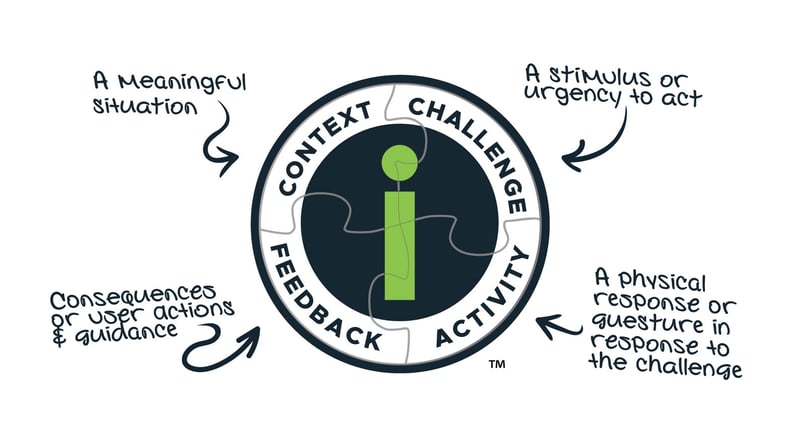Blog
4 Lenses To Bring e-Learning Instructional Design Into Focus: Part 1 - ...
This article was originally published by eLearning Industry. Read Part 1 here. Let's look at CCAF Design for Instructional Interactivity through the ...


4 Lenses To Bring e-Learning Instructional Design Into Focus With CCAF—Part 2
By Ethan Edwards | August 26, 2021 | Custom Learning | 1 Comment
This article was originally published by eLearning Industry.
Read Part 1 here.
Let's look at CCAF Design for Instructional Interactivity through the perspective of different considerations for eLearning instructional design.
Lens Two: Adult Learning
This is the second in a series of articles looking at the Allen Interactions CCAF Model for Instructional Interactivity through the perspective of different considerations for eLearning instructional design. In this article, I take up the principles of adult learning and ask if CCAF is in alignment with those principles.
First, here’s a quick summary of CCAF. This interactive learning design approach, first published in Michael Allen’s Guide to eLearning [1], defines instructional interactivity with four essential elements: context, challenge, activity, and feedback. Following the CCAF Model as a design framework for learning provides a reliable process to improve and elevate the kind of teaching interactions that will create lasting and meaningful change.
CCAF e-Learning Instructional Design Model: 4 Components
CCAF stipulates that an engaging and effective instructional interaction integrates these 4 elements.
- Context
Context provides meaning and relevance. It communicates to the learner that the skills and knowledge have meaning and usefulness in the real world. - Challenge
Challenge is used to engage the learners’ emotions, motivating them to engage authentically and with intention. Challenge is created through risk, meaningful consequences, and achievable goals. - Activity
Activity refers to the gestures required of the learner. Gestures should evoke knowledge and actions that exist in the performance environment and can be applied beyond the eLearning course. - Feedback
Feedback is how the learner responds and adapts to learner actions—where learning outcomes are validated and reinforced. Feedback indicates correctness but also communicates how the learner can improve.
The Power Of CCAF Vs. Principles Of Adult Learning
At least in the training world, we typically deal with adult learners. While there isn’t evidence that learning is significantly different from children to adults per se, there are characteristics widely shared across adult learners that should be considered when developing training materials for a primarily adult audience. Let’s look at how CCAF accommodates these patterns of learning.
Self-Determination
Adult learners often have a mature self-concept and expect opportunities to work independently under self-direction. They are accustomed to making decisions, setting goals, and assessing their performance in most aspects of their lives. It is hugely unmotivating when aspects of control are removed from the adult learner in training.
Adult learners do not want to be told what to do. It’s important for adults to make decisions about their learning. They want a voice in how they learn and even when they learn. For many, getting to choose a strategy for exploring materials is important. Where and when they start and stop should be under the learner’s control.
A fundamental characteristic of CCAF is that the learner is told (in the traditional sense) very little. Instead, the learning is led by choices (actions) the learner makes when confronted with meaningful challenges. The content is most effectively delivered to the learner through Feedback as a response to the learner’s choices. Learners often feel like they are in control, even when they are progressing through a carefully determined setting or Context.
Experience
Adult learners have a lifetime of experiences from which to draw. As designers, we should not forget that adults have this edge over younger learners. In certain areas, their knowledge and experience, even in the areas you are teaching, may be extensive. This knowledge must be recognized, respected, and tapped into in order to engage adults. Ignoring this reality and designing training that treats all learners uniformly while ignoring prior experience, skills, and aptitude results in training that is often rejected by its intended users.
When implemented well, CCAF creates rich opportunities for learners to use existing knowledge and keen learning strategies. CCAF should be part of a test-then-tell structure. The Context demonstrates relevance to the learners’ world, in which they are expected to respond or perform some task. A learner whose prior experiences lead to immediate success will move on through the lesson with great speed. It is a highly satisfactory, reinforcing process. Learners for whom this content is new will likely stumble in responding to the Challenge; this is a critical trigger for the lesson to “tell” or provide corrective information to the learner.
Readiness To Learn
Unlike students in more traditional education settings, adult learners often approach learning with a pre-identified skill or job role in mind. They are ready to take responsibility for their learning, but they must believe that it is meaningful and related to Challenges that they recognize in their own lives. Adults are likely to reject Activities that involve skills that appear irrelevant or unhelpful. On the other hand, learners will invest authentic effort in Activities if they believe the tasks represent productive learning.
Traditional content presentation and simple comprehension interactivity often fail to connect with learners because the material is presented in the abstract and seems removed from the real world. CCAF can only exist when a relevant setting, meaningful to the user, is embedded and serves as the foundation for individual interactions and indeed for the entire lesson. Adult learners engage when the direct benefit of the instruction is apparent and immediate. Simulations can be a very effective application of CCAF thinking; they are useful and appealing to many learners when the simulation scenarios link directly to the existing Challenges the learner is facing in real life.
Orientation To Learn
Adults come to training with a purpose. They expect to immediately apply new knowledge. Training content value is directly connected to usefulness. Adults (when encouraged) are critical thinkers and want to see how something works and to try it. They are less prone to accept something simply because the instructor said it. In other words, adults learn by problem-solving.
Designers often don’t have the time nor resources to build elaborate problem-solving interactions. But even for simple interactions, CCAF inserts a problem-solving framework. Learners are not told upfront but seek, discover, and validate decisions and actions. Consequences, rather than simplistic judgment delivered as feedback, support, and empowering learn-by-doing strategy that engages most adults.
Motivation To Learn
Adults have mature values, beliefs, and opinions. These personal convictions can have a huge impact on motivation. When these values are ignored or mismatched with superficial indicators of success, learners can actively resist learning. Adults will often be motivated by their internal convictions more than by external prompts in a learning setting. Intrinsic rewards for success in a task the learner values personally are often a sufficient (or even stronger) motivator than the more typical external prompts and rewards in a learning environment.
In CCAF, tapping into existing motivators within the learner is a foundational idea. The Context and Challenge should be designed specifically to tap into typical existing motivators in the target audience. It is far more efficient to build on what the learner is interested in and ready to do rather than to try to force an artificial outcome on the learner.
CCAF: A Comprehensive Model
CCAF was designed primarily with an awareness of how to create a meaningful exchange in an independent, individualized learning setting. In achieving that goal, it also quite masterfully supports the principle things we understand about adult learners. Our experience suggests that it is the most impactful strategy for creating eLearning that truly makes a difference.
Create Interactive e-Learning Instructional Designs with the 4 Pillars Playbook!

About the Author: Ethan Edwards
Ethan Edwards draws from more than 30 years of industry experience as an elearning instructional designer and developer. He is responsible for the delivery of the internal and external training and communications that reflect Allen Interactions’ unique perspective on creating Meaningful, Memorable, and Motivational learning solutions backed by the best instructional design and latest technologies.
Comments
Extremely interesting. Thank you for giving such an informative blog.
Would you like to leave a comment?
Related Blog Posts

By: Ethan Edwards | Jan, 2021
Category: Custom Learning

Blog
Pillar II for Transformative e-Learning Instructional Design: Challenge
This article was originally published by eLearning Industry. Read Part 1 here. Let's look at CCAF Design for Instructional Interactivity through the ...
By: Ethan Edwards | Feb, 2021
Category: Custom Learning

Blog
Pillar III for Transformative e-Learning Instructional Design: Activity
This article was originally published by eLearning Industry. Read Part 1 here. Let's look at CCAF Design for Instructional Interactivity through the ...
By: Ethan Edwards | Mar, 2021
Category: Custom Learning




jerry miller miller
9/25/2021, 5:28 PM